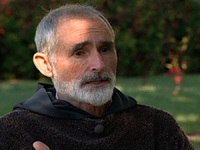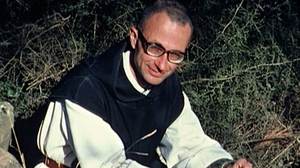 Brother Paul Quenon, OCSO, has been a monk for 52 years. That is, he’s been trying to live in God and by learning to deepen one’s capacity to love in community; that’s how he describes life as a Trappist monk. A one-time spiritual son of Father Louis (Thomas Merton), Brother Paul lives a contemplative life –that is, on the margins of society but at the center of the Church. His witness is a life of proclaiming the beauty of Christ from an abbey of the Strict Observance of Cistercians. Religion and Ethics Newsweekly‘s Judy Valente interviewed Brother Paul recently at his home, the Abbey of Gethsemani.
Brother Paul Quenon, OCSO, has been a monk for 52 years. That is, he’s been trying to live in God and by learning to deepen one’s capacity to love in community; that’s how he describes life as a Trappist monk. A one-time spiritual son of Father Louis (Thomas Merton), Brother Paul lives a contemplative life –that is, on the margins of society but at the center of the Church. His witness is a life of proclaiming the beauty of Christ from an abbey of the Strict Observance of Cistercians. Religion and Ethics Newsweekly‘s Judy Valente interviewed Brother Paul recently at his home, the Abbey of Gethsemani.
Tag: Trappist
James Martin reviews “Of Gods and Men”
The culture editor at America Magazine Jesuit Father James Martin, reviews the stunning movie “Of Gods and Men” on Religion and Ethics Newsweekly. His comments are worth hearing.
Saint Stephen Harding
Today the Church –though localized to the Cistercian Order– celebrates the liturgical memorial of Saint Stephen Harding, one of the 3 founders of the Cistercian reform of Benedictine monastic life. Most of the faithful would not know of Saint Stephen unless they had contact with the Cistercians or remember their church history class.
Several things distinguish Saint Stephen Harding: he was English, he was the third abbot of Cîteaux, he was a man of great pragmatism, he was the author of the Charter of Charity (the foundational document of the Cistercian life), and was responsible for the liturgical formulations for this way of life, cleaning up the corruptions inserted into the Divine Office over the years.
On Saint Stephen’s deathbed he said, I assure you that I go to God in fear and trembling. If my baseness should be found to have ever done any good, even in this I fear, lest I should not have preserved that grace with the humility and care I ought.
For more on Saint Stephen Harding read this entry and this one.
Is there a desire for God still present today?
A few days ago I recommended seeing “Of Gods and Men.” Last week I saw the film and I have still been thinking of the movie, the monks, the hard work of inter-religious dialog. The testament of Dom Christian de Cherge can be read here. I highly recommend reading what Prior Christian said and what others think. A group of friends took time to see the movie together. Two friends brought a perspective of the film to my attention recently. The following is an an answer to those who ask whether a desire for God is still present in our times. Angelo Scola writes:
I believe that the worldwide success of the film on the Tibhirine
monks [U.S. Title: “Of Gods and Men”] reflects a burning desire in the men and
women of any latitude to meet the face of God; it therefore reflects the real
need we all feel for authentic witnesses who may help us keep our gazes focused
upwards.
Authentic witness is, in fact, not limited to “giving a good example”.
It shines in all its wholeness as a method for practically knowing reality and
communicating truth. It is a primary value, standing above any other form of
knowledge and communication – scientific, philosophical, theological, artistic,
etc.
A luminous example of this method is offered by the very words which Fr
Christian de Chergé, prior of the Trappist monastery of Notre-Dame de l’Atlas
in Tibhirine, Algeria, wrote in his spiritual will [noted above], a good three years before
he was massacred with his monks:
“When the time comes, I would like to be able
to have an instant of lucidity that would allow me to ask for the pardon of God
and that of men, my brothers, while forgiving with all my heart those who may
have hit me… I cannot see how I could, in fact, rejoice in that this people I
love could be accused of my assassination. It
Continue reading Is there a desire for God still present today?
Of Gods and Men
Xavier Beauvois’ new film “Of Gods and Men” (Des Hommes et des Dieux) is an intense and moving film of 7 Trappist monks in Algeria who had a coexistence with Muslim neighbors until extremists threatened and killed the monks. The Atlas Martyrs gave their lives in the night of 27-28 March 1996.
John Kiser wrote of the monks in his 2002 The Monks of Tibhirine which I recommend to give you a sense of what’s going on here.
“Of Gods and Men” is being shown on the East coast, now in NYC and next week in New Haven. Here’s the trailor.
Know the monks: Atlas Martyrs Biographies.pdf
Love is eternal hope…
Trappist monks donate coffin to bury little Christina Green in Arizona
A beautiful of gesture of charity and hope was given to us as a witness of gospel virtue by the monks of a Trappist monastery in Iowa this week when they gave the Green family the casket in which to bury 9 year old Christina, a victim of the shootings last week. The CNN story is here.
Special thanks to Dom Brendan and the monks of New Melleray Abbey!
Lectio Divina: 9 qualities of doing
At yesterday’s terrific conference on Lectio Divina, the keynote presenter, Trappist Brother Simeon Levia, monk of Saint Joseph’s Abbey, Spencer, MA, gave an incredible talk on doing the work of Lectio Divina at a conference on Lectio sponsored by Mario Paredes and his staff at the American Bible Society. Brother Simeon is an established Catholic thinker.
Fr André Louf, OCSO RIP
 The Trappist monk and prominent theologian and retreat master, Father André Louf, died on July 12, 2010. Louf was a monk of Mont-des-Cats, in France. He was born in 1929 in Leuven, Belgium; he entered the monastery in 1947 and elected abbot of his monastery in 1963, a ministry he exercised for 34 years. Upon retirement in 1997 he lived as a hermit and served for a while as a chaplain to a group of nun in the south of France.
The Trappist monk and prominent theologian and retreat master, Father André Louf, died on July 12, 2010. Louf was a monk of Mont-des-Cats, in France. He was born in 1929 in Leuven, Belgium; he entered the monastery in 1947 and elected abbot of his monastery in 1963, a ministry he exercised for 34 years. Upon retirement in 1997 he lived as a hermit and served for a while as a chaplain to a group of nun in the south of France.
Famously he was the author of the 2004 meditations of the Way of the Cross at the invitation of Pope John Paul II. If you’ve not read them, get your hands on a copy which are available online.
… The sentiment which, in the end, will prevail for the truly humble person is an unshakeable confidence in God’s mercy of which he has tasted at least a glimmer even in the midst of failure. How then could he doubt any longer? (A. Louf, The Way of Humility)
His obit is here.
May Father André’s memory be eternal!
Film explores the witness of Trappist martyrs of Algeria
 The
The
recent Cannes Film Festival showed the film about the 1996 Trappist martyrs of Our Lady of
Atlas in Algeria. The film got rave reviews and awarded 2nd place. The film is in French and it will be
available on DVD with English subtitles. While we wait for the full film to be available here is
a clip on Youtube with subtitles at: Of Gods and Men.
Blessed Maria Gabriella dell’Unità (Sagghedù)
…that they all may be one, as thou, Father, in me, and I in thee; that they also may be one in us: that the world may believe that thou hast sent me (John 17:21).
In simplicity of heart I gladly offer everything, O Lord.
The Lord put me on this path, he will remember to sustain me in battle.
To His mercy I entrust my frailty.
I saw in front of me a big cross…,
I thought that my sacrifice was nothing in comparison to His.
I offered myself entirely and I do not withdraw the given word.
God’s will whatever it may be, this is my joy, my happiness, my peace.
I will never be able to thank enough.
I cannot say but these words:” My God, your Glory.”
Blessed Maria Gabriella
 Praying for unity is not a matter reserved only to those who actually experience the lack of unity among Christians. In the deep personal dialogue which each of us must carry on with the Lord in prayer, concern for unity cannot be absent. Only in this way, in fact, will that concern fully become part of the reality of our life and of commitments we have taken on in the Church. It was in order to reaffirm this duty that I set before the faithful of the Catholic Church a model which I consider exemplary, the model of a Trappistine Sister, Blessed Maria Gabriella of Unity, whom I beatified on 25 January 1983. Sister Maria Gabriella, called by her vocation to be apart from the world, devoted her life to meditation and prayer centered on Chapter 17 of St. John’s Gospel and offered her life for Christian Unity. This is truly the cornerstone of all prayer: the total and unconditional offering of one’s life to the Father; through the Son, in the Holy Spirit. The example of Sister Mara Gabriella is instructive; it helps us to understand that there are no special times, situations, or places of prayer for unity. Christ’s prayer to the Father is offered as a model for everyone, always and everywhere.
Praying for unity is not a matter reserved only to those who actually experience the lack of unity among Christians. In the deep personal dialogue which each of us must carry on with the Lord in prayer, concern for unity cannot be absent. Only in this way, in fact, will that concern fully become part of the reality of our life and of commitments we have taken on in the Church. It was in order to reaffirm this duty that I set before the faithful of the Catholic Church a model which I consider exemplary, the model of a Trappistine Sister, Blessed Maria Gabriella of Unity, whom I beatified on 25 January 1983. Sister Maria Gabriella, called by her vocation to be apart from the world, devoted her life to meditation and prayer centered on Chapter 17 of St. John’s Gospel and offered her life for Christian Unity. This is truly the cornerstone of all prayer: the total and unconditional offering of one’s life to the Father; through the Son, in the Holy Spirit. The example of Sister Mara Gabriella is instructive; it helps us to understand that there are no special times, situations, or places of prayer for unity. Christ’s prayer to the Father is offered as a model for everyone, always and everywhere.
(Pope John Paul II, Ut unum sint, 1995, 27)




